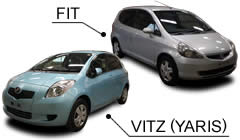Battle Of The Subcompacts: Comparing The Toyota Vitz/Yaris To The Honda Fit - Vol.184
Owning a subcompact car has many advantages. It is smaller and thus typically easier to handle. The lighter weight of the car commonly translates into better fuel-efficiency. When it comes to the pocketbook, subcompact cars are cheaper to buy and maintain than most regular-sized and especially oversized automobile offerings. Parking is typically easier, and there are locations that offer parking for subcompact cars only. While drivers who have large families or who often haul cargo would be better served by larger cars, subcompacts offer a good alternative to drivers who typically drive solo or for young couples who want an efficient ride to get them from one place to another.

Two of the top subcompacts on the market today are the Honda Fit and the Toyota Vitz, which is known as the Yaris in markets outside of Japan. As far as comparisons go, both of the cars offer a 1.5 liter, four-cylinder engine; the engine on the Honda Fit offers 117 horsepower as compared to the 106 offered by the Toyota Vitz. While the two engines are fairly similar in specifics, the 2013 Honda Fit offers an estimated twenty-seven miles per gallon for city driving and thirty-three miles per gallon highway cruising. For the Toyota Vitz, the estimates are a little higher, coming in at thirty mpg for the city and an impressive thirty-seven mpg for highway driving. It is important to remember that the Honda engine does offer higher horsepower, which translates into the lower numbers when compared to the Vitz' fuel efficiency. With the addition horsepower in the engine, the Fit is a little more speedy when it comes to on the road performance.
When it comes to the interior, though, the Toyota Vitz falls behind the Honda Fit. The Fit offers around sixty cubic feet of cargo space when the back seats are folded down, approximately ten cubic feet more than the Vitz. Both of the models feature split back seats, which means that one or both of the seats can be folded down to increase the cargo capacity in the back. The opening on the Vitz, however, is wider than the Fit, making it possible to get bigger items into the back of the car more easily. While the Fit excels in the amount of cargo capacity in the back, its backseat can feel a little cramped at times, to put it lightly. The Vitz offers a superior back seat that does not feel quite so constrained, which means longer passenger trips are more feasible beyond just a couple. It can also be easier to get babies and young children, those who are required to ride in carriers and car seats, in and out of the car.
The transmission for the Vitz is a standard automatic transmission, but the Honda Fit offers what is known as a continuously variable transmission, or CVT for short. While the idea behind the CVT is sound--the transmission is constantly shifting to maximize the output of the motor--they can be difficult to replace and even more expensive than a typical automatic transmission. Older CVTs are more prone to show wear and tear than a standard automatic, though CVTs do offer smoother rides. This can become an issue for buyers who are seeking long-term returns on their investment of subcompact cars.
Overall, the Toyota Vitz offers the reliability of the Toyota brand, a more fuel-efficient engine, a ggbier back seat and a wider hatch for moving cargo in and out of the car. On the other hand, the Honda Fit has been designed to maximize the amount of cargo that can be hauled in the back of the car. The Fit is slightly less fuel-efficient, but it is a faster, zippier little car that will meet most drivers' needs, which is really the most important factor when deciding on which car to purchase.